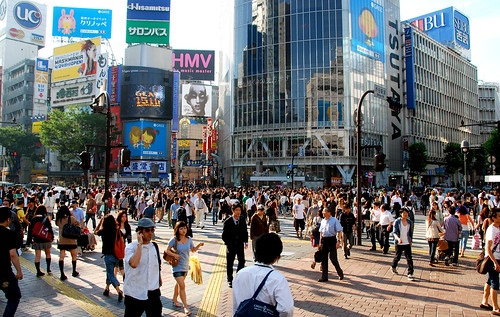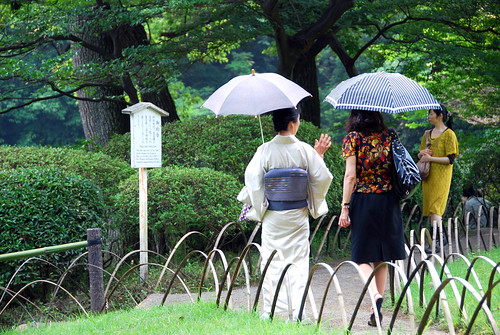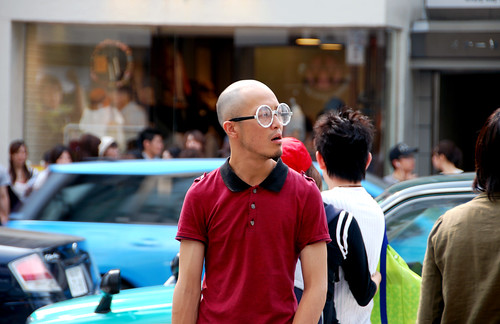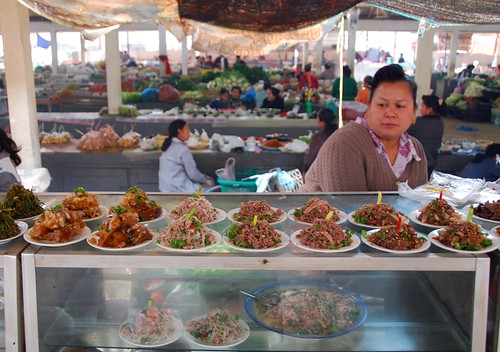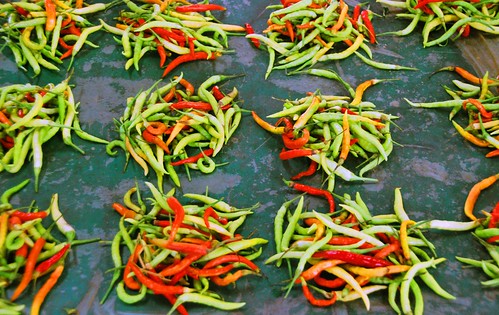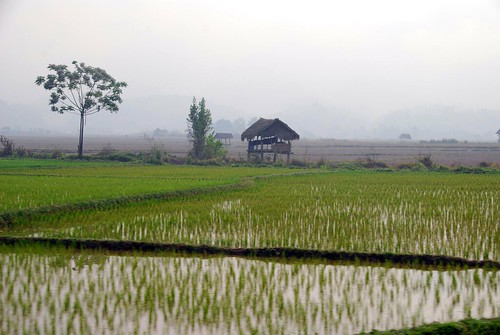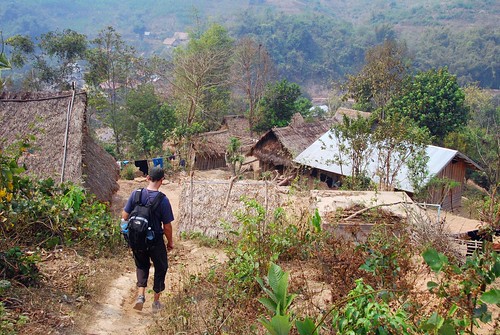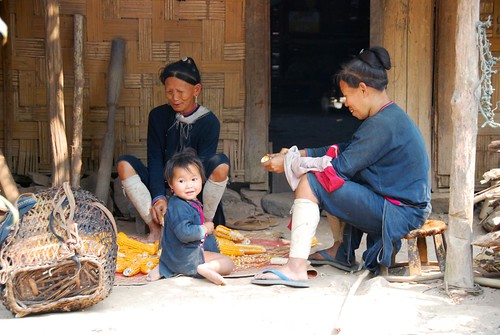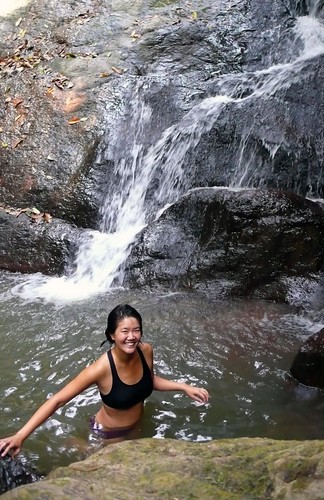Japan
When you think of Japan, you probably think of sushi; and when you think of sushi in Japan you probably think of Tokyo’s famous fish market. In addition to being the world’s largest wholesaler of fish, Tsukiji is a full-on tourist destination, one of the few that actually lives up to the hype.
Visiting Tsukiji can feel like a pilgrimage of sorts. For one, you have to wake up at the ungodly hour of 4:30AM if you want to catch the tuna auction, which starts around 5AM and ends by 7AM. Not only that, you have to be quick on your toes in those early morning hours! You see, Tsukiji is an actual, operating fish market, so there is a lot happening in those wee hours of the morn’…most notably the three-wheeled carts whizzing by you at breakneck speeds. In some cases, it feels like they are trying to hit you (and in some cases, I bet they are. I imagine a bunch of dazed and confused tourists wandering around your workplace is really frustrating when you are trying to do your job).
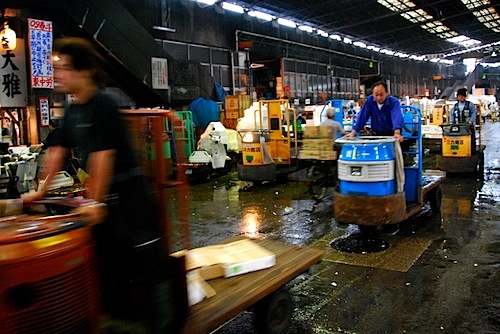
Three-wheeled carts whizzing around Tsukiji.
In fact, we sort of feel lucky that we’re able to see the fish market and tuna action at all, because rude tourists have almost shut the place down to visitors. Apparently, there were tourists handling the fish—kicking them like tires and even riding them as if they were bulls! I can’t even imagine how horrifying it would be to see a drunken (or not) lout sitting on top of a hundred thousand yen tuna…and particularly in Japan, a culture that revolves so completely around being reserved and respectful. Bad tourists! Bad, bad tourists!
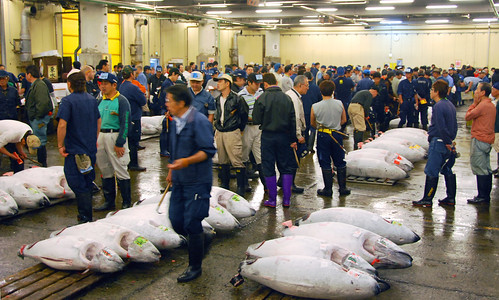
The tuna auction hall in action.
Actually, the one time we experience anything other than courtesy from Japanese people is at the fish market. We were quietly and unobtrusively watching a guy cut up his enormous tuna with increasingly larger and larger swords when another fishmonger came by, slapped both me and Jeremy on the arm, and yelled at us to “GO HOME!!! GO!!! GO HOME!!!” Though it was rude and shocking, I can’t say that I blame him…I would hate tourists too if I worked at Tsukiji.
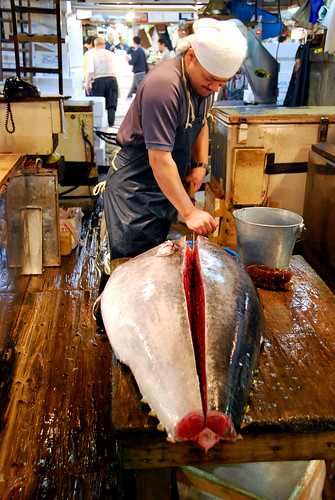
This is the guy we were watching when we got yelled at by the fishmonger. We were really entranced by the whole tuna filleting process! He washed down both the fish and the table in between each cut and had a special tool for each slice. It was clear that he took a lot of care in preparing this huge creature for eventual consumption.
Visitors to the tuna auction are now confined to a narrow band of space within the auction hall no wider than a sidewalk (apparently you used to be able to walk amongst the fish and the buyers). But even from afar, it was totally fascinating and fun to watch the auction. Each auctioneer had his own unique, captivating style…see for yourselves:
After the tuna auction closed, we wandered around the absolutely enormous market (seriously, we visited the Sydney Fish Market back in January and Tokyo’s version is easily 25 times the size of that market) and watched people carving tuna (both frozen and fresh).
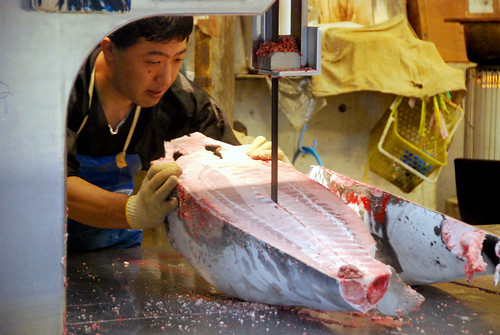
Cutting frozen tuna with a bandsaw.
We also saw a huge variety of sea creatures, both recognizable and not.
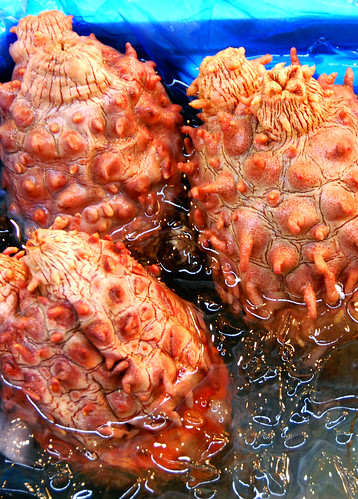
Unidentified sea creature. Anyone know what this is?
Like most other visitors, we completed our visit with a sushi breakfast—another Tsukiji rite of passage, no matter that you’re chowing down on raw fish at 8 o’ clock in the morning. If we had to do it over again, we’d probably eat our sushi right outside of the market, where the prices are easily half of what they are inside the market stalls.
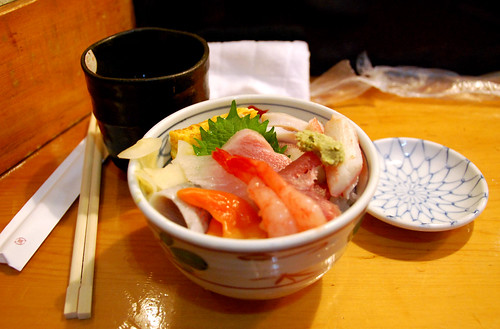
Our Tsukiji chirashi breakfast.
And, with our bellies full of raw, delicious fish, we went back to Joy’s apartment to take a nap. ![]()
See all of our photos from Tsukiji Fish Market on our Flickr
One thing that has really delighted us on our travels is the fact that our assumptions about a place have very often been completely wrong (particularly in Asia). We thought Taipei would be dirty and crowded. Wrong—Taipei is a clean, modern city that holds it’s 2 million residents comfortably. We thought China’s streets would still be swarmed with bicycles and people wearing Mao jackets. Wrong again—the rising middle class here means there are more cars than bikes, and most people have discarded the drab Communist-era rags for any and every patterned and blinged-out piece of clothing they could get their hands on. And we thought Tokyo would be a huge, crazy metropolis. Take a wild guess if we were right or wrong on that one.
To be fair, I guess in some ways, Tokyo is sort of crazy. I mean, there are a lot of people, especially around Shibuya and Harajuku.
The difference is that Tokyo doesn’t feel chaotic at all. Perhaps this lack of chaos owes itself to the fact that the Japan is such a rules-based society, and the rules here say that citizens should be orderly and polite, treat others with kindness and the utmost respect, and speak in a low tone of voice. In fact, we can’t get over how quiet it is here! No honking horns, no blaring music, no clanking of wheels, no sounds of construction. Granted, our aural radars might be off a bit after China, where someone turned the volume up to 11, and then broke the knob off.
This is one of the most delightful things about Tokyo—how peaceful it is for a big, cosmopolitan city. And, similar to our reaction to Taiwan after SE Asia—it’s just so civilized here! I mean, the taxi drivers wear full suits, hats, and little white gloves! There are little lace covers on the seats, some taxi drivers give you free lollipops, and the doors even open and close automatically! Now that’s classy!
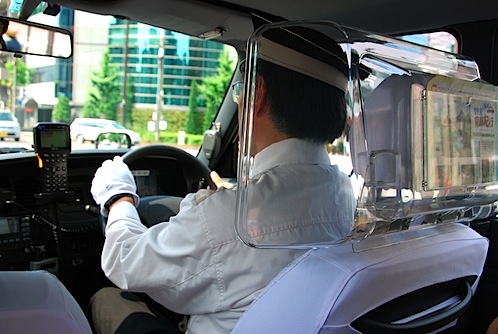
From the back seat of a Japanese taxi.
But of course, we don’t like Tokyo just because it’s quiet (that was just the icing on the cake). Make no mistake: Tokyo is a beautiful, vibrant city…
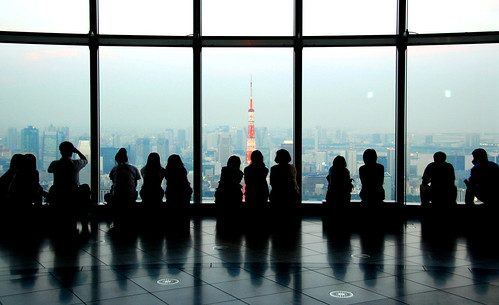
View of Tokyo Tower from the top of the Mori Building.
…full of little quirks and oddities…
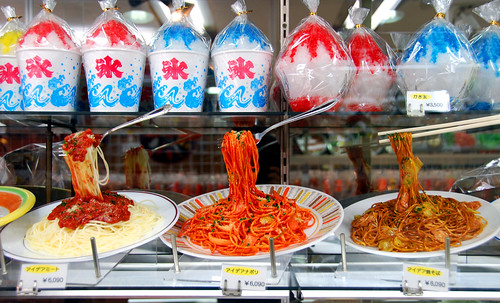
Kappabashi dori in Tokyo, a restaurant supply street, where you can buy all manner of red paper lanterns, chopstick holders, and yes, plastic food.
A pachinko parlor in Tokyo. Pachinko is a strange gambling game that looks like a pinball machine; the player shoots a ball straight up into the machine and depending on where it lands, you can win more balls, which you can trade for tokens, which you can then trade for cash at some other location (gambling is illegal in Japan, so this is how they circumvent the laws).
…beautiful gardens…
Women walking through the gardens near Meiji jingu.
…and funky people, who take care in their appearance, whatever that style happens to be.
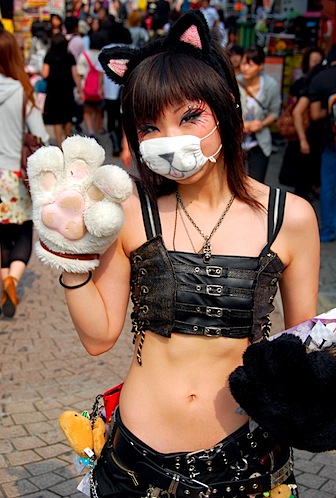
Kitty cat girl in the Harajuku area.
It is a city that delights in technology and innovation…one look at their toilets, and you know that they are light years ahead of us in the States. Toilets in Japan come with some serious functionality: automatic open opening and closing of the lid. Bidets with varying levels of pressure. Fans and heated dryers (for use after the bidet). Automatic flushing. And (our favorite): some toilets even play music, or a “flushing water” sound, so that you can do your business without worrying that the person in the stall over will be disturbed by any, um, noises.
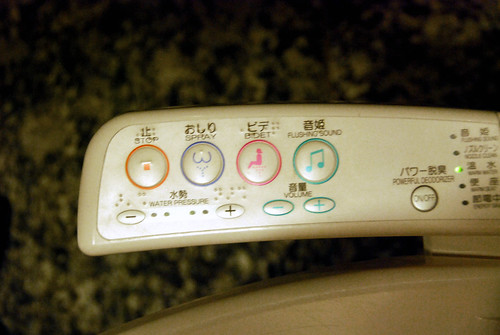
Typical control panel on a Japanese toilet.
Despite this fascination with all things new and novel, Tokyo still manages to preserve it’s traditional culture. We saw women getting on the high-speed bullet train in their kimono and dessert chefs checking their cell phones in between hand-rolling Japanese-style candies. And it seems, to the outsider, anyway, that this balance between the new and the old is preserved without tension, and without feeling contrived. It is simply Tokyo doing what it does best—embracing it’s Japanese-ness with dignity and delight, and welcoming you along for the ride.
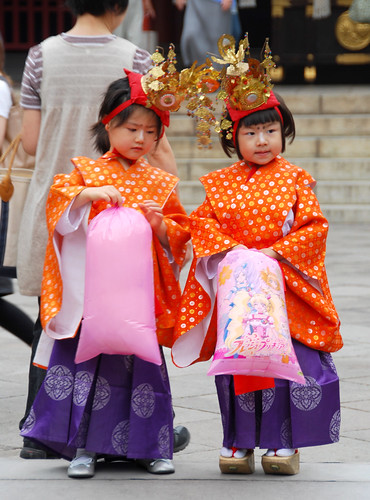
Little girls in traditional kimono and headdress at a local temple, holding on tight to their bags of cotton candy.
We step off the plane in Tokyo, and we discover something extraordinary: we have x-ray vision!
At least, that’s what it felt like, seeing the world without smog. It was like someone flipped the switch on our retinas from regular broadcast to HDTV. As we get closer to the city, we discover another super sense: our hearing has turned supersonic! Tokyo is a huge, sprawling metropolis, but somehow, the city is dead quiet. Where is the constant honking? The people yelling at each other on the streets? The tour groups following a megaphone-wielding tour guide?
Even at the airport, Jeremy and I couldn’t stop talking about how different Japan is from China. There were two ladies whose only discernible job was to bow at you as you got on the escalator and say “Irashaimase!” (”Welcome!”). The ticket-taker bowed at our bus as it left the curbside. And the smokers! They had to walk outside and go into what can only be described as a Smoking Box (it was like observing animals at the zoo…Oooh! Look! It’s the Commonicus Smokeritus!), so that their exhalations wouldn’t bother us non-smokers out on the sidewalk. How is it that Japan and China are even on the same planet, much less the same continent?!?

The Smoking Box at the airport. Smokers have to leave the terminal and enter this box in order to light up, so that their exhalations don’t bother other people out on the sidewalk.
Japan can strike fear into the heart of any budget traveler, but as soon as we land, we can see that we’re going to want to extend our stay, even without any solid plans for our trip here. It is just so freakin’ peaceful in this country (even in the big city), and after a month of Chinese chaos, we’re ready to decompress, watch the world through HD, and listen to the glorious sound of (relative) silence.
But, good lord is it expensive! Luckily, we’ve hooked up with an old college friend of Jeremy’s named Joy, who is a Japanese-American expat working in Tokyo, and she’s offered to help us plan our itinerary while putting us up in the huge, gorgeous apartment she shares with her Aussie boyfriend Alex in the Akasaka district of Tokyo. This is a real treat—I was sure that, given our budget, we were going to have to rent out a spot in Kramer’s chest of drawers.
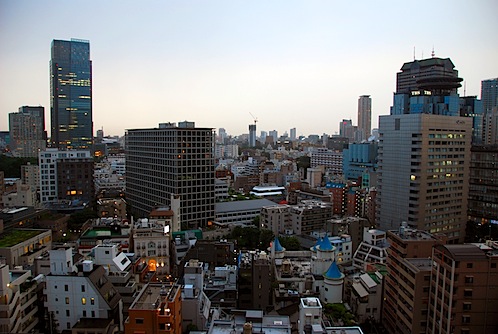
The view from Joy and Alex’s apartment.
The last time Jeremy bumped into Joy was in SF, and the occasion was actually on our first date—over 6 years ago! Through a crazy Flickr coincidence involving my wedding dress and Joy’s friend Jean, we’ve gotten back in touch with her. Joy is an AMAZING hostess…not only does she love food like we do, but she was mindful of our budget, and she swiftly went to work taking us to all these incredible midrange restaurants around Tokyo. Even better, because we’re saving so much on hotels by staying with Joy and Alex, we actually have some leeway in our budget to sample some of this famously delicious Japanese cuisine.
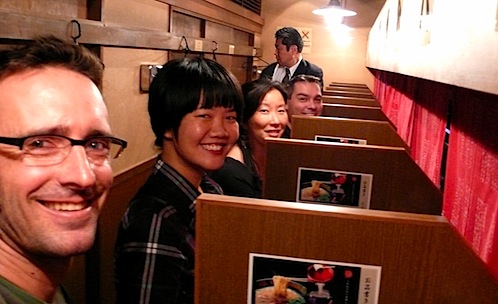
Out with Joy and Alex at our first Japanese ramen experience. You purchase tickets for your ramen via a vending machine, and you personalize your bowl of noodles by filling out a questionnaire, indicating how fatty you like your broth to be, how many green onions you want, if you want pepper flakes, etc. I felt like we were taking a ramen test! A server lifts up the red curtain in your stall, slides your ramen towards you, and you chow down in your own personal noodle-wrestling booth. No cheating allowed!
OK, but first: did you know that there are no street names in Tokyo? No, seriously. For real. Japan’s capital city—a city of over 12 million people—has no street names. Why did we not know this?!? Joy kept explaining how to get to a destination with instructions like, “turn left at the love hotel that looks like a castle,” “it’s a few shops past the mermaid bar,” or, even better, making us go out on her balcony and explaining the route with a bird’s eye view of the city. We were getting increasingly frustrated and couldn’t understand why she wouldn’t just say “turn left at so-and-so street.” Until we realized that there is no such thing as “so-and-so street.”
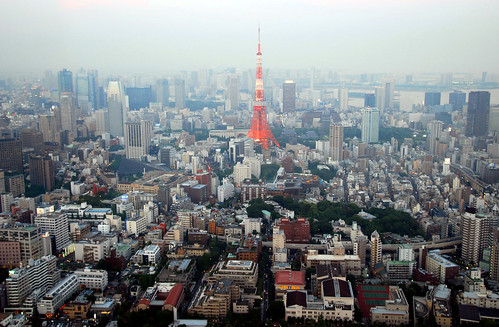
View of Tokyo Tower from the Mori Building. At least that’s easy to find—just look for the big red pointy thing.
Further, buildings are numbered in a totally random fashion—by the date they were built. So finding a restaurant or bar is usually a bit of an adventure—typically, you just get to the general area, and then you have to ask around to see if anyone can point you to your final destination. Then once you finally find your destination, the first thing you do is a grab a card (in case you ever want to come back—all business cards in Tokyo are printed with a map describing the establishment’s location), and look around you, trying to sear the surroundings into your brain so you have some way of finding the place again (Is it next to a strange looking sign or statue? Is there a unique building across the street?). Jeremy and I found this process totally fascinating…I mean, what does it say about a culture when everything—including the location of your apartment—relies on context?
Making things even more difficult is the fact that very few people speak English here. Luckily, we are usually out with Joy (who speaks Japanese)…and when we’re not out with Joy, we are out with Joy’s instructions, which explain very clearly how to get from point A to point B. This makes the experience on finding stuff in Tokyo a lot less stressful than it could be. I have to admit, I don’t miss being the only one able to speak the local language. ![]()
Despite the difficulties (which actually just make things more endearing), Jeremy and I quickly become enamored with this beautiful culture. In fact, we see a lot of similarities between Japan and Taiwan (which also hold a special place in our hearts)—particularly the fact that everyone is exceedingly polite and just plain helpful. In some ways (this is going to make my Dad have a heart attack), it almost seems like Taiwan would have an easier time (culturally, anyway) merging with Japan than it would with China.
But it’s the little things that make us really fall hard for this country: the fact that most of the ice cubes in Tokyo are hand-chiseled (really, they’re gorgeous). The elaborate toilets. The beautiful manhole covers. The amazingly fashionable people (women in Tokyo can give you a serious ugly duckling complex, especially when you’re wearing Keens). And yes, the sweet, sweet silence. Of course, it doesn’t hurt that the food is incredible.
Yes, I think we’re going to like it here. ![]()
While most people spend their days in southern SE Asia lying around on pristine beaches, drinking fresh fruit shakes, and snorkeling in warm ocean water, the north’s main activity is trekking, usually to hill-tribe minority villages. Multi-day treks are very popular in northern Vietnam, Laos, and Thailand. We had such an amazing time on our Sapa trek, we decided to head north from Luang Prabang towards Luang Nam Tha, a small town that doesn’t seem to have much going on for it except that it makes a convenient base for exploring the nearby Nam Ha National Protected Area (NPA). LNT has been celebrated for its commitment to ecotourism principles…local tour agencies not only limit the number of trekkers in a group in order to diminish the impact on the environment, but they ensure that a large percentage of the trek fee (usually about 30%) goes towards the village, and each agency offers completely different trek routes so that money coming into the area is distributed fairly amongst the minority tribes. Sounds awesome, huh?
Well, it was and it wasn’t. From what we understand, the LNT tourism industry is still in its infancy, and there were some odd practices in place that didn’t really gel with us—namely, the pricing system. Basically, the more people that sign up for a trek, the less each individual in the group needs to pay. Basically, this means that when you sign up for a trek, you have no idea how much you will end up paying for it. You might pay US$60 each if it’s just two of you, or as little as US$25 each if 6 more people sign up after you. It’s really frustrating.
What ends up happening is that people searching for treks wander around from agency to agency, looking for a trek that already has other people signed up. And since LNT is not super heavily touristed, everyone waits and waits until another person or couple signs up before they sign up, in order to ensure that they will not pay top dollar for their tour.
So, we waited all day hoping that another person or couple would sign up for a two-day tour. At 7PM, when no one had signed up yet, we finally gave up and booked a tour. BUT, because it would have been really expensive (like US$75 each) for a two-day trek (since it was only the two of us), we decided just to do a day hike. In retrospect, we should have signed up EARLIER in the day rather than later, so that other people playing the same waiting game might have signed on to our trek.
Annoying, dontcha think?
We met our tour guide Noo (pronounced “no-oh”) in the morning, and she was very shy. Laotians in general are very reserved, extremely polite people (which is VERY different from the rest of SE Asia). Our first stop was the local market, where (we found out later) Noo was picking up our lunch.
We were absolutely amazed by the market…it was clean, organized, quiet, and odor-free; quite an enormous change from the other markets we had been to in SE Asia. I mean, the produce was all organized into little piles! The butcher area had all the assorted animal parts, but there was not even a hint of smell! Even the dirt floor looked swept-clean somehow.
Even weirder: as I was wandering around the market, I saw a family selling bamboo shoots…and some small (dead) songbirds, a mouse, and what looked like a ferret or long squirrel. I took a photo and the family quickly covered the dead animals up under palm leaves (If you want to see the photo, click here, I won’t post it in case someone out there is squeamish about seeing a dead ferret/squirrel thingy). I thought maybe they had hunted these animals illegally, but Noo thought they were just embarrassed. We have seen some really, really weird stuff for sale in SE Asia markets (remember the “ba”?) and nobody has ever tried to hide anything from our cameras. This was like a Bizarro market!
After the market, we headed out to a local village to start our trek. The drive was stunning…a gorgeous landscape of rice paddies studded with bamboo shacks.
We walked through a dusty village and headed into a dusty forest. Little did we know that the great majority of our hike would be within this dense cover. I mean, isn’t the point of a hike to see stuff? Noo did point out local fruits and bird feathers and that sort of thing, but we didn’t see much for several hours except dusty trail and trees. When we did get to a clearing, the smoke was so thick from the local slash-and-burn agriculture that we couldn’t see very far anyway.
At some point, Noo told us it was lunch time and she ran off into the forest. We were sitting there wondering what she was doing when she came back with a handful of palm leaves, which would become our lunch table.
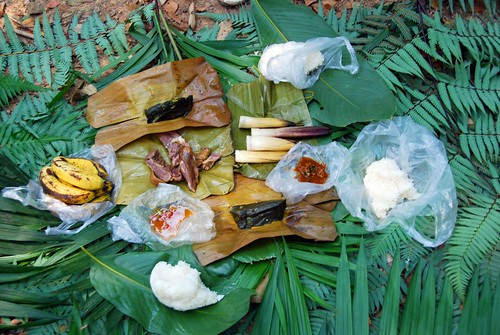
Our lunch spread of roasted duck, bamboo shoots, river weed (I wasn’t crazy about this), and sticky rice.
Finally, we were out of the forest and descending into a village. Now we’re talking!
We saw a little cutie helping her family de-kernel some corn.
The village was small and it only took us about 10 minutes to walk through it on our way to the local waterfall. The waterfall was cool…there were dozens of tiers ending in small pools where you could go for a swim. Noo led us all the way up to what seemed like the very furthest pool (which is good, the water is cleaner upriver). The water was really cold, so I did my usual thing of getting in really, really slowly (I know it hurts more that way, but I can’t help it). Noo surprised both me and Jeremy by yelling, “Here, let me help you!” and splashing me! This quiet, reserved girl who had said maybe 3 words on her own the entire trek was now showering me with cold water! Well, it worked, I finally got in. ![]()
So, that was out experience in Luang Nam Tha. I don’t really feel like we saw much and we kinda paid a lot for it (our day trip was US$37 each, I think…for reference, we paid US$23 for two days in Sapa). Noo was sweet but she ain’t no Thuyen. ![]() I’m kinda glad that we didn’t end up doing a 2-day trek because I’m not sure if the scenery would have been much better. Jeremy and I both think the 2- and 3-day trekking trails probably just meander through more dusty forest (though you would get to stay in a village for the night).
I’m kinda glad that we didn’t end up doing a 2-day trek because I’m not sure if the scenery would have been much better. Jeremy and I both think the 2- and 3-day trekking trails probably just meander through more dusty forest (though you would get to stay in a village for the night).
I guess the lesson here is, if you ever go to LNT:
1. Sign up early in the day for the trek YOU want; someone else will probably follow.
2. Don’t go during burning season.
I think you could safely say that our experience in LNT was kind of a bust. We really admire the commitment to sustainable and fair tourism here, but let’s just hope they work out the kinks so that people who make the effort to get out to LNT can spread the word.


